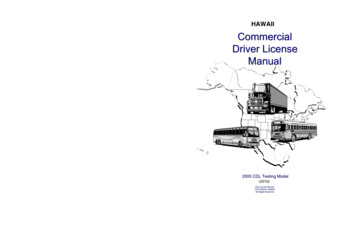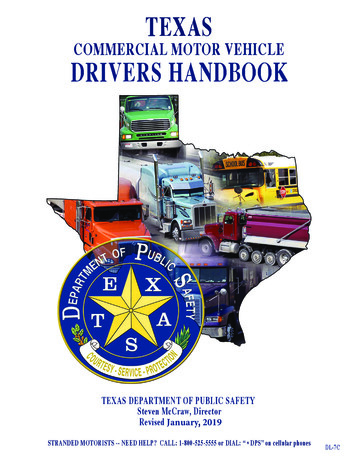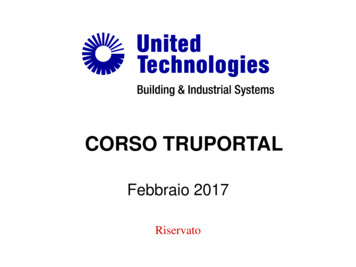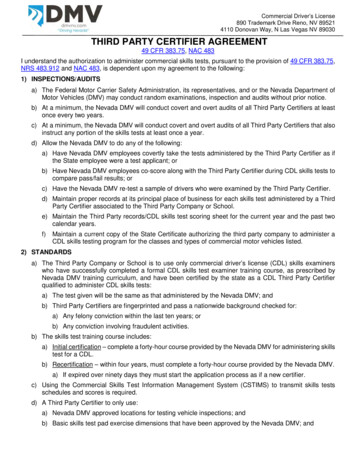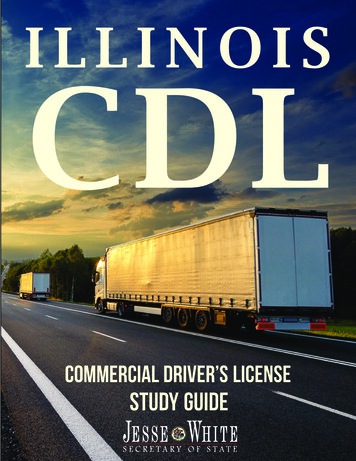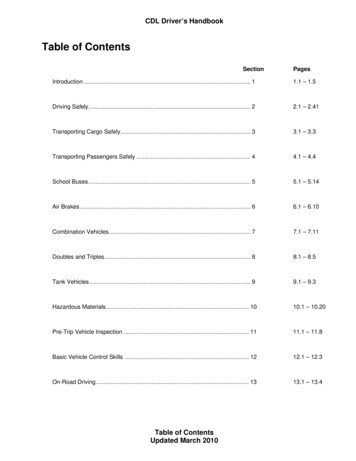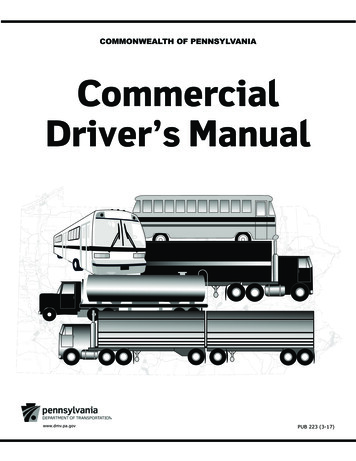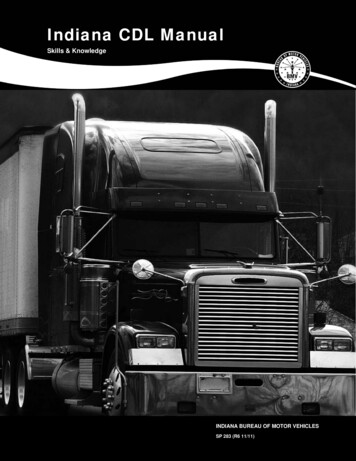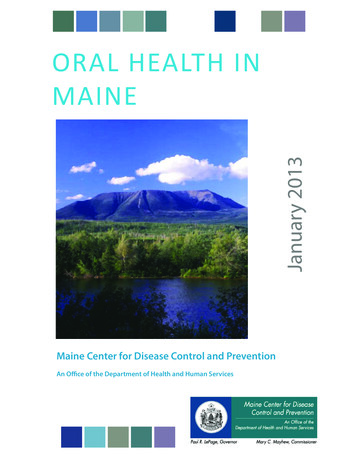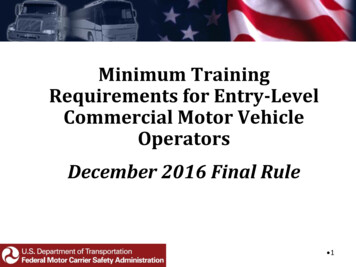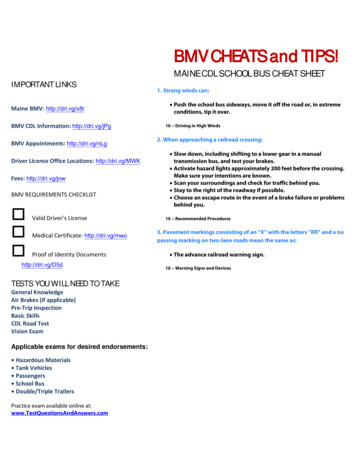
Transcription
BMV CHEATS and TIPS!IMPORTANT LINKSMaine BMV: http://dri.vg/x8rBMV CDL Information: http://dri.vg/jPgBMV Appointments: http://dri.vg/nLgDriver License Office Locations: http://dri.vg/MWKFees: http://dri.vg/jowBMV REQUIREMENTS CHECKLIST Valid Driver’s LicenseMedical Certificate: http://dri.vg/mwoProof of Identity Documents:http://dri.vg/D5dTESTS YOU WILL NEED TO TAKEGeneral KnowledgeAir Brakes (if applicable)Pre-Trip InspectionBasic SkillsCDL Road TestVision ExamApplicable exams for desired endorsements: Hazardous Materials Tank Vehicles Passengers School Bus Double/Triple TrailersPractice exam available online at:www.TestQuestionsAndAnswers.comMAINE CDL SCHOOL BUS CHEAT SHEET1. Strong winds can: Push the school bus sideways, move it off the road or, in extremeconditions, tip it over.10 --- Driving in High Winds2. When approaching a railroad crossing: Slow down, including shifting to a lower gear in a manualtransmission bus, and test your brakes. Activate hazard lights approximately 200 feet before the crossing.Make sure your intentions are known. Scan your surroundings and check for traffic behind you. Stay to the right of the roadway if possible. Choose an escape route in the event of a brake failure or problemsbehind you.10 --- Recommended Procedures3. Pavement markings consisting of an ‘‘X’’ with the letters ’’RR’’ and a nopassing marking on two-lane roads mean the same as: The advance railroad warning sign.10 --- Warning Signs and Devices
BMV CHEATS and TIPS!MAINE CDL SCHOOL BUS CHEAT SHEET4. At a railroad-highway crossings with gates with flashing red lights and bells: Stop when the lights begin to flash and before the gate lowers across the road lane.10 --- Warning Signs and Devices5. When loading the school bus, if there is a student missing: Ask the other students where the student is.10 --- Loading Procedures6. If there is more than one track at a railroad crossing: Make sure all tracks are clear before crossing.10 --- Warning Signs and Devices7. Approaching a school bus stop involves the proper use of: Mirrors. Alternating flashing lights. Moveable stop signal arm and crossing control arm, when equipped.10 --- Approaching the Stop8. When you are at the railroad crossing: Stop no closer than 15 feet and no farther than 50 feet from the nearest rail, where you have the best view of thetracks. Place the transmission in Park, or if there is no Park shift point, in Neutral and press down on the service brake or setthe parking brakes. Turn off all radios and noisy equipment, and silence the passengers. Open the service door and driver’s window. Look and listen for an approaching train.10 --- Recommended Procedures9. The Department of Transportation requires that antilock braking systems (ABS) be installed on: Air brakes vehicles, (trucks, buses, trailers and converter dollies) built on or after March 1, 1998. Hydraulically braked trucks and buses with a gross vehicle weight rating of 10,000 lbs. or more built on or afterMarch 1, 1999.10 --- Vehicles Required to Have Antilock Braking Systems
BMV CHEATS and TIPS!MAINE CDL SCHOOL BUS CHEAT SHEET10. An anti-lock braking systems (ABS): Helps you avoid wheel lock up and maintain control.10 --- How ABS Helps You11. The danger zone is the area on all sides of the bus where children are in the most danger of being hit, either by: Another vehicle or their own bus.10 --- Danger Zones12. If the gate comes down after you have started across the railroad tracks: Drive through it even if it means you will break the gate.10 --- Recommended Procedures13. When unloading at the school you should secure the bus by: Turning off the ignition switch. Removing key if leaving driver’s compartment.10--- Unloading Procedures at School14. The school bus has blind spots: Immediately below and in front of each mirror.Directly in back of the rear bumper.10 --- Outside Left and Right Side Flat Mirrors15. Anti-lock braking systems (ABS) won’t: Allow you to drive faster, follow more closely, or drive less carefully. Prevent power or turning skids---ABS should prevent brake-induced skids but not those caused by spinning the drivewheels or going too fast in a turn. Necessarily shorten stopping distance. Increase or decrease ultimate stopping power---ABS is an ‘‘add-on’’ to your normal brakes, not a replacement forthem. Change the way you normally brake. Under normal brake conditions, your vehicle will stop as it always stopped. Compensate for bad brakes or poor brake maintenance.10 --- Safety Reminders
BMV CHEATS and TIPS!MAINE CDL SCHOOL BUS CHEAT SHEET16. In general, in regard to railroad crossings: School buses must stop at all crossings, and ensure it is safe before proceeding across the tracks.10 --- Recommended Procedures17. If you have to leave your seat to deal with a student’s behavioral issue: Secure the bus; take the ignition key with you if you leave your seat.10 --- Handling Serious Problems18. Always focus on students as they approach the bus and watch for: Any who disappear from sight.10 --- Special Dangers of Loading and Unloading19. When driving a vehicle with an anti-lock braking systems (ABS), remember: The best vehicle safety feature is still a safe driver. Drive so you never need to use your ABS. If you need it, ABS could help to prevent a serious crash.10 --- Safety Reminders20. Any problems or special situations found during your post trip inspection: Should be reported immediately to your supervisor or school authorities.10--- Post-trip Inspection21. To avoid student injuries by getting caught on the handrail or the door: You should closely observe all students exiting the bus to confirm that they are in a safe location prior to movingthe bus.10 --- Special Dangers of Loading and Unloading22. Before operating a school bus: Check each mirror to obtain maximum viewing area; if necessary, have the mirrors adjusted.10 --- Correct Mirror Adjustment
BMV CHEATS and TIPS!MAINE CDL SCHOOL BUS CHEAT SHEET23. If you feel that a student’s offense is serious enough that you cannot safely drive the bus: Call for a school administrator or the police to come and remove the student. Always follow your state or local procedures for requesting assistance.10 --- Handling Serious Problems24. After receiving your signal to cross the roadway, students should: Cross far enough in front of the school bus to be in your view. Stop at the left edge of the school bus, stop, and look again for your signal to continue to cross the roadway. Look for traffic in both directions, making sure roadway is clear. Proceed across the roadway, continuing to look in all directions.10 --- Unloading Procedures on the Route25. When unloading students: Count the number of students while unloading to confirm the location of all students before pulling away from thestop.10 --- Unloading Procedures on the Route26. When approaching a school bus stop, you should: Move as far as possible to the right on the traveled portion of the roadway.10 --- Approaching the Stop27. All school bus stops should be approved by: The school district prior to making the stop.10 --- Approaching the Stop28. The tail swing of a school bus can extend up to: 3 feet.10 --- Tail Swing29. When approaching a crossing with a signal or stop sign on the opposite side: Be certain the bus has enough "containment or storage" area to completely clear the railroad tracks on the otherside if there is a need to stop.
BMV CHEATS and TIPS!MAINE CDL SCHOOL BUS CHEAT SHEET10 --- Special Situations30. Braking hard on a slippery surface in a vehicle without anti-lock braking systems (ABS): Could cause your wheels to lock up leading to skidding, loss of steering, and spinning of the vehicle.10 --- How ABS Helps You31. After evacuating the bus and ensuring the safety of the students: Protect the scene. Set out emergency warning devices as necessary and appropriate. Prepare information for emergency responders.10 --- Evacuation Procedures32. Limited visibility requiring use of the roof mounted strobe light means: You cannot easily see around you --- in front, behind, or beside the school bus. Your visibility could be only slightly limited or it could be so bad that you can see nothing at all.10 --- Strobe Lights33. If there is a behavior problem on the bus while loading or unloading students: Don’t take your eyes off what is happening outside the bus.10 --- Don’t Deal with On-bus Problems When Loading and Unloading34. After loading the bus, when all students are accounted for, prepare to leave by: Closing the door. Engaging the transmission. Releasing the parking brake. Turning off alternating flashing red lights. Turning on left turn signal. Checking all mirrors again. Allowing congested traffic to disperse. Entering the traffic flow only when it is safe to do so.10 --- Loading Procedures35. Passive railroad crossings require you to: Recognize the crossing. Search for any train using the tracks, and; Decide if there is sufficient clear space to cross safely.
BMV CHEATS and TIPS!MAINE CDL SCHOOL BUS CHEAT SHEET10 --- Types of Crossings36. During an emergency evacuation, if there is no radio, or the radio is inoperable: Dispatch a passing motorist or area resident to call for help. As a last resort, dispatch two older, responsible students to go for help.10 --- Evacuation Procedures37. Laws and regulations governing how school buses must operate at railroad-highway crossings: Vary in each state: it is important for you to understand and obey these state laws and regulations.10 --- Recommended Procedures38. To tell if your bus has an anti-lock braking systems (ABS) installed: Your school bus will have a yellow ABS malfunction lamp on the instrument panel if it is equipped with ABS.10 – Vehicles Required to Have Antilock Braking Systems39. When approaching a school bus stop, you should turn on the right turn signal indicator: About 100-300 feet or approximately 3-5 seconds before pulling over.10 --- Approaching the Stop40. Before allowing students to unload: Check all mirrors.10 --- Unloading Procedures on the Route41. When dealing with a student’s behavioral issue: Speak in a courteous manner with a firm voice. Remind the offender of the expected behavior. Do not show anger, but do show that you mean business.10 --- Handling Serious Problems42. If you are caught in strong winds: Keep a strong grip on the steering wheel. Try to anticipate gusts. You should slow down to lessen the effect of the wind, or pull off the roadway and wait.
BMV CHEATS and TIPS!MAINE CDL SCHOOL BUS CHEAT SHEET Contact your dispatcher to get more information on how to proceed.10 --- Driving in High Winds43. The overhead inside rearview mirror is located: Directly above the windshield on the driver’s side area of the bus.10 --- Overhead Inside Rearview Mirror44. The railroad crossbuck sign requires you to: Yield the right-of-way to the train.10 --- Warning Signs and Devices45. After loading students and before moving the bus: Wait until students are seated and facing forward.10 --- Loading Procedures46. When crossing railroad tracks: Cross the tracks in a low gear.Do not change gears while crossing.10 --- Recommended Procedures47. After stopping at a school bus stop, open service door, if possible, enough to activate alternating red lights when: Traffic is a safe distance from the school bus.10 --- Approaching the Stop48. The advance railroad warning sign tells you to: Slow down. Look and listen for the train. Be prepared to stop at the tracks if a train is coming.10 --- Warning Signs and Devices49. Upon exiting the bus, students should be told to: Walk at least 10 feet away from the side of the bus to a position where the driver can plainly see all students.
BMV CHEATS and TIPS!MAINE CDL SCHOOL BUS CHEAT SHEET10 --- Unloading Procedures on the Route50. If you have missed a student’s unloading stop: Do not back up; be sure to follow local procedures.10 --- Unloading Procedures on the Route51. When you drive a vehicle with an anti-lock braking systems (ABS), you should: Brake as you always have.10 --- Braking with ABS52. In an emergency situation, student safety and control is best maintained by: Keeping students on the bus during an emergency and/or impending crisis situation, if so doing does not exposethem to unnecessary risk or injury.10 --- Planning for Emergencies53. When considering evacuating students from the bus: Do not move a student you believe may have suffered a neck or spinal injury unless his or her life is in immediatedanger. Special procedures must be used to move neck spinal injury victims to prevent further injury.10 --- Evacuation Procedures54. If you must back your bus, the lookout should not: Give directions on how to back the bus.10 --- Backing55. If your bus stalls or is trapped on the tracks: Get everyone out and off the tracks immediately. Move everyone far from the bus at an angle, which is both away from the tracks and toward the train.10 --- Special Situations56. If there is a serious behavioral problem with a student: Stop the bus; park in a safe location off the road, perhaps a parking lot or a driveway.
BMV CHEATS and TIPS!MAINE CDL SCHOOL BUS CHEAT SHEET10 --- Handling Serious Problems57. In an emergency situation, a decision to evacuate should include consideration of the following conditions: Is there a fire or danger of fire? Is there a smell of raw or leaking fuel? Is there a chance the bus could be hit by other vehicles? Is the bus in the path of a sighted tornado or rising waters? Are there downed power lines? Would removing students expose them to speeding traffic, severe weather, or a dangerous environment such asdowned power lines? Would moving students complicate injuries such as neck and back injuries and fractures? Is there a hazardous spill involved? Sometimes, it may be safer to remain on the bus and not come in contact withthe material.10 --- Planning for Emergencies58. The outside left and right side flat mirrors are used to: Monitor traffic, check clearances and students on the sides and to the rear of the bus.10 --- Outside Left and Right Side Flat Mirrors59. Students have been injured or killed when clothing, accessories, or even parts of their body: Get caught in the handrail or door as they exited the bus.10 --- Special Dangers of Loading and Unloading60. If the anti-lock braking systems (ABS) malfunction lamp stays on after the bulb check, or goes on once you are underway: You may have lost ABS control at one or more wheels.10 --- Braking if ABS is Not Working61. The outside left and right side crossover mirrors presents a view of people and objects that: Does not accurately reflect their size and distance from the bus.
BMV CHEATS and TIPS!MAINE CDL SCHOOL BUS CHEAT SHEET10 --- Tail Swing62. To monitor the tail swing of your bus: You need to check your mirrors before and during any turning movements.10 --- Tail Swing63. Passive railroad crossings: Do not have any type of traffic control device.10 --- Types of Crossings64. If you must back-up at a student pick-up point, be sure to: Pick up students before backing and watch for late comers at all times.10 --- Backing65. Even if there are active railroad signals that indicate the tracks are clear: You must look and listen to be sure it is safe to proceed.10 --- Special Situations66. If a student should drop an object, he/she should be taught to: Leave any dropped object and move to a point of safety out of the danger zones and attempt to get the driver’sattention to retrieve the object.10 --- Special Dangers of Loading and Unloading67. You should position the overhead inside rearview mirror to see: The top of the rear window in the top of the mirror. All of the students, including the heads of the students right behind you.10 --- Overhead Inside Rearview Mirror68. If the gate stays down after the train passes: Do not drive around the gate. Instead, call your dispatcher.
BMV CHEATS and TIPS!MAINE CDL SCHOOL BUS CHEAT SHEET10 --- Warning Signs and Devices69. School bus danger zones may extend as much as: 30 feet from the front bumper with the first 10 feet being the most dangerous. 10 feet from the left and right sides of the bus. 10 feet behind the rear bumper of the school bus.10 --- Danger Zones70. Active railroad crossings: Have traffic control devices including flashing red lights, with or without bells and flashing red lights with bells andgates.10 --- Types of Crossings71. When the road crosses over more than one set of tracks: A sign below the crossbuck indicates the number of tracks.10 --- Warning Signs and Devices72. To plan for emergencies, when possible, assign: Two responsible, older student assistants to each emergency exit. Assign another student assistant to lead the students to a ‘‘safe place’’ after evacuation.10 --- Evacuation Procedures73. After ordering an evacuation of the bus: Direct a student assistant to lead students to the nearest safe place. Walk through the bus to ensure no students remain on the bus. Retrieve emergency equipment. Join waiting students. Account for all students and check for their safety.10 --- Evacuation Procedures74. When loading or unloading students in the dark: The dome light should be on.10 --- Loading Procedures75. When you drive a vehicle with ABS, you should brake as you always have. In other words:
BMV CHEATS and TIPS!MAINE CDL SCHOOL BUS CHEAT SHEET Use only the braking force necessary to stop safely and stay in control. Brake the same way, regardless of whether you have ABS on the bus. However, in emergency braking, do not pumpthe brakes on a bus with ABS. As you slow down, monitor your bus and back off the brakes (if it is safe to do so) to stay in control.10 --- Braking with ABS76. If your anti-lock braking systems (ABS) should fail: You still have normal brake functions; drive and brake as you always have.10 --- Braking if ABS is Not Working77. If there is a white line painted on the pavement before the railroad tracks: The front of the school bus must remain behind this line while stopped at the crossing.10 --- Warning Signs and Devices78. The blind spot behind the bus extends: 50 to 150 feet and could extend up to 400 feet depending on the length and width of the bus.10 --- Outside Left and Right Side Flat Mirrors79. In spite of the placement of the overhead inside rearview mirror, there is a blind spot: Directly behind the driver’s seat. That begins at the rear bumper and could extend up to 400 feet or more behind the bus.10 --- Overhead Inside Rearview Mirror80. If the bus is in the direct path of a sighted tornado and evacuation is ordered, escort students to: A nearby ditch or culvert if shelter in a building is not readily available, and direct them to lie face down, handscovering their head. They should be far enough away so the bus cannot topple on them. Avoid areas that are subject to flash floods.10 --- Evacuation Procedures81. If there is a need to evacuate where fire is present: Lead students upwind of the bus.
BMV CHEATS and TIPS!MAINE CDL SCHOOL BUS CHEAT SHEET10 --- Evacuation Procedures82. While students are boarding, the driver should: Monitor all mirrors continuously.10 --- Loading Procedures83. The convex mirrors present a view of people and objects that: Does not accurately reflect their size and distance from the bus.10 --- Outside Left and Right Side Convex Mirrors84. When stopping at a school bus stop, place the transmission in: Park, or if there is no Park shift point, in Neutral and set the parking brake at each stop.10 --- Approaching the Stop85. If older, responsible students are not on the bus at the time of the emergency: Emergency evacuation procedures must be explained to all students, including knowing how to operate the variousemergency exits and the importance of listening to and following all instructions given by you.10 --- Evacuation Procedures86. In regard to railroad crossings: Be especially careful at ‘‘passive’’ crossings that do not have any type of traffic control device.10 --- Special Situations87. A safe place to evacuate students will be: At least 100 feet off the road in the direction of oncoming traffic. This will keep the students from being hit by debrisif another vehicle collides with the bus.10 --- Evacuation Procedures88. is vital to the safe operation of the school bus in order to observe the danger zone around the bus and lookfor students, traffic, and other objects in this area. Proper adjustment and use of all mirrors
BMV CHEATS and TIPS!MAINE CDL SCHOOL BUS CHEAT SHEET10 --- Correct Mirror Adjustment89. If there is a serious behavioral problem with a student: Never put a student off the bus except at school or at his or her designated school bus stop.10 --- Handling Serious Problems90. When students are loading at the school campus, you should: Turn off the ignition switch. Remove key if leaving driver’s compartment. Position yourself to supervise loading as required or recommended by your state or local regulations.10 --- Loading Procedures91. It is imperative that you learn and obey the laws and regulations governing loading/unloading operations: In your state.10 --- Loading and Unloading92. You should position the convex mirrors to see: The entire side of the bus up to the mirror mounts. Front of the rear tires touching the ground. At least one traffic lane on either side of the bus.10 --- Outside Left and Right Side Convex Mirrors93. If there is a behavior problem on the bus: Concentrate on the driving task first; if necessary, pull the bus over to handle the problem.10 --- Don’t Deal with On-bus Problems When Loading and Unloading94. When your route or school activity trip is finished, you should walk through and around the bus looking for: Articles left on the bus. Sleeping students. Open windows and doors. Mechanical/operational problems with the bus, with special attention to items that are unique to school buses --mirror systems, flashing warning lamps and stop signal arms. Damage or vandalism.
BMV CHEATS and TIPS!MAINE CDL SCHOOL BUS CHEAT SHEET10 --- Post-trip Inspection95. When at a railroad track, stop: No closer than 15 feet and no farther than 50 feet from the nearest rail, where you have the best view of the tracks.10 --- Recommended Procedures96. Anti-lock braking systems (ABS) will: Help maintain vehicle control, but won’t always shorten stopping distance. Help to prevent a serious crash.10 --- Safety Reminders97. The overhead inside rearview mirror is used to: Monitor passenger activity inside the bus. Provide limited visibility directly in back of the bus if the bus is equipped with a glass-bottomed rear emergencydoor.10 --- Overhead Inside Rearview Mirror98. If your anti-lock braking systems (ABS) malfunctions: You still have regular brakes; drive normally, but get the system serviced soon.10 --- Braking if ABS is Not Working99. In an emergency situation, determine the best type of evacuation: Front, rear or side door evacuation, or some combination of doors. Roof or window evacuation.10 --- Evacuation Procedures
MAINE CDL SCHOOL BUS CHEAT SHEET . 1. Strong winds can: Push the school bus sideways, move it off the road or, in extreme conditions, tip it over. 10 --- Driving in High Winds. 2. When approaching a railroad crossing: Slow down, including shifting to a lower gear in a manual transmission bus, and test your brakes.
